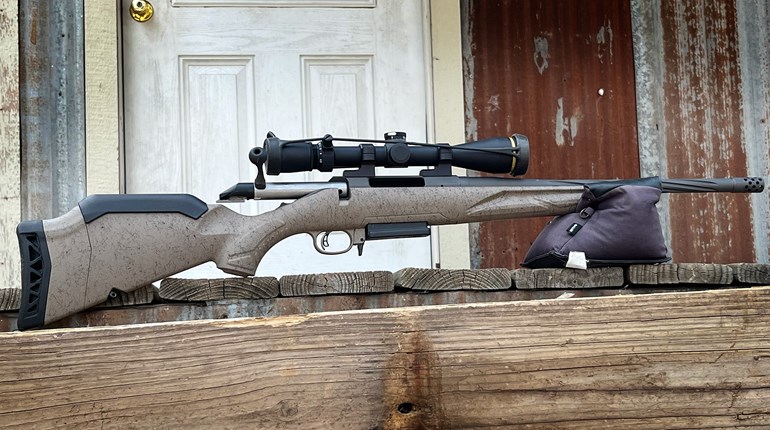
Pink streaked the eastern sky when Neal Emery and I climbed into the blind, but it was still pitch dark. I’d driven into Arapahoe, Neb., the night before … in a driving snowstorm. Now the sky was clear, but I had no feel for the country, just a vague sense that the tower blind sat in the middle of a huge CRP field. Neal had taken a fine buck a few days earlier, so he offered to sit with me the first morning and show me the place.
Shortly after daybreak we caught a glint of antlers off toward the northern edge of the CRP. Mostly that’s all we could see—antlers above tall grass and weeds—but it was a very nice buck, tall, wide and heavy. He was about 400 yards out, too far for my 7x57. That was my excuse, but the truth is I didn’t really want to shoot. I’d just arrived, and, though windy, it was cold and clear after the storm passed. I wanted to hunt, not just shoot.
As the morning progressed the CRP came alive with deer. A couple of young bucks chased does under the stand. A tall, heavy 8-pointer, a no-brainer shooter, came by at 150 yards, followed by a really cool old buck with funky antlers. I could have shot either very easily, but I dithered. It wasn’t that they weren’t big enough. They were plenty big enough. But I was enjoying an awesome November morning during the rut and I didn’t want to end it.
In the daylight, now educated on the property, I understood that the primary cover—other than CRP—was a winding creek bottom, mostly lined with cottonwoods and occasional stands of cedar. Up from the watercourse there was some grain but mostly hayfields. In mornings and evenings pheasants cackled, and I saw several coveys of bobwhites. There were lots of whitetails, and Rio Grande turkeys were plentiful. Just a few hours’ drive from my place in Kansas, the country was altogether different, and it was a game-rich paradise.
Chasing Phantoms
I should have shot that first morning. I’m not altogether certain why I didn’t, but as Shakespeare almost wrote, “There were bucks and rumors of bucks.” A few days earlier Neal had taken a fine buck … but he was still agonizing because he thought it was the wrong deer.
An exceptional buck was seen during archery season, and again the first days of rifle season. An experienced hunter (read: “tagged out”) called him a possible “190.” In the several years the Hornady folks had this country leased it would be the biggest buck ever. So from that moment everyone was looking for that buck. Neal almost passed his gorgeous buck because he knew it wasn’t the big one.
Honest, I didn’t pass those bucks because I expected to see the monster. Whitetail hunting requires realism. The country was unfamiliar, I was hunting the last of the rifle season and I had just a few days. On the other hand, once you shoot it’s all over. Buck movement was so good at first that I was curious to see what else might pop up. The next morning was clear, bright and calm: perfect. I went back to the CRP stand with confidence: I didn’t expect to see that “190,” but I expected to see at least one of the three shooters I’d seen the previous day. In fact, I was so confident I stayed there all day, dawn to dark. There was some distant movement to the north and along the creek to the west, but I hardly saw any deer in the CRP.
A problem with hunting unfamiliar country is you don’t know what you don’t know. The weedy jungle of that CRP seemed ideal bedding and security cover, but we don’t have anything quite like it in my part of Kansas. Purely as a theory, deer moved into it during the storm and stayed there while it was windy—but moved out when it calmed. I never again laid eyes on any of those three bucks that I should have shot!
Too quickly it came to the last day of the season, another cold, clear and calm dawn. From the CRP we’d glassed deer moving along a treeline to the north, so I rolled the dice and climbed into an open tower up there. I’m no longer at a point where I “have to” fill a tag, but the 7x57 I carried was brand new. I wanted to break it in—and I was no longer worried about being picky. It was still very gray when I saw a dark form emerge from the creek bottom and work its way along the treeline toward me. From the body shape I was sure it was a mature buck, and as it got closer and the light started to come up I could see antlers. I didn’t look at them very closely. Instead I checked my watch. When the buck was as close as it seemed likely to get I was solidly into legal shooting time, and I took the shot.
The buck was a grownup deer, but the antlers were poor, much smaller than bucks I’d passed. That’s the way it goes sometimes, but one more lesson was to come.
A few weeks later I saw Neal Emery at the Hornady booth at Dallas Safari Club and he showed me a picture of the “190” everyone had been looking for, taken by the hunter who’d seen it. The buck looked big, but it wasn’t a great picture. Neal had blown it up and compared point by point. It was the buck he had shot, heavy and handsome, a fine whitetail—but nothing close to the rumor!
Greener Pastures?
We have about 35 million whitetail deer pursued by 10 million deer hunters: the most populous wild large mammal on Earth and the largest hunting culture. Most American hunters, however, pursue their sport close to home. There are huge advantages to this. You can learn your country and your deer. You can hunt throughout the season(s), or pounce when weather and rut conditions are best. Whether your goal is to fill the freezer or wait for a nice buck for your area, you know your deer, and you know what your area is likely to produce.
Across the huge range of the whitetail deer some areas are “better” than others, defined by genetics and nutrition, higher densities, better buck-to-doe ratios, less hunting pressure or some combination. And even if not “better,” there’s a lot of great whitetail country that’s different from your home area, and thus interesting. We humans have a tendency to believe the grass must be greener elsewhere, and some of us are compelled to explore those greener pastures. These days I have pretty good “backyard whitetail hunting” at my Kansas place, but I’m still driven to explore what might be greener pastures.
Last year I hunted new (to me) country in western Nebraska; later I hunted a favorite place in Georgia—both far different from oak-cloaked Kansas ridges. Over the years I’ve hunted whitetails in a lot of places, some famous for big bucks. No matter how great the place, it seems to me there are three disadvantages to hunting whitetails far from home.
First, unfamiliar country is always difficult. Whitetail sign doesn’t change much, but movement patterns vary with climate, vegetation and topography. This is mitigated by a guided hunt or a buddy hunt, where somebody knows what’s going on. But unlike a lot of situations, with whitetail hunting you’re usually alone; the best a guide or buddy can do is direct you to a good stand. A more serious disadvantage is, when hunting far from home, you just about have to pick a certain time period. You can’t know what the weather will be like, and you can’t predict the exact status of the rut. Ideally, distant hunts can be planned when the moon is dark. But often season dates and schedules mean that the moon phase has to be accepted for what it is.
Although not as important as the first two, another vexing issue with hunting unfamiliar animals is knowing when to shoot and when to hold off. Well, unless it’s genuinely the buck of a lifetime, you can’t really know—but in strange country the decision is difficult and usually must be made in seconds. When planning a distant hunt it’s only natural to have some expectation of taking a larger buck than is likely on your home turf. Hey, expectations can be real or unrealistic; either way they might not be realized! But one of the things I’ve learned is you can’t stockpile mature whitetails. If you see a buck that meets your criteria take the shot; it’s unlikely you’ll see that buck again. Of course, you can always hold out for greatness, or you can settle for less. If you do the former you may come up empty-handed, and that’s fine. If you settle, then you are cancelling your chance for greatness. In unfamiliar country it’s difficult to know the right choice.
Georgia Pines
Obviously I did it wrong in Nebraska. I passed bucks I shouldn’t have passed, and at the tail end I settled. After our Kansas season I went down to buddy Zack Aultman’s place in southern Georgia. It’s a pine plantation, blocks of mature timber alternated with second growth and interspersed with food plots. The whitetails are fantastic. But the cover is thick, so the only practical technique is stand-hunting over openings. I get down there every couple of years, so it isn’t altogether unfamiliar—but I don’t pretend to know it well. On the other hand, I know what’s there. I’ve seen great bucks come into camp—and those Georgia pines produced one of my own very best whitetails.
It’s a place where I’m prepared to pass—and also a place where, by camp rules, young bucks must not be taken. You have to be careful! As with all long-range hunts, I had to pick a time, and latter December was my only window. I knew the rut would be over, but in that place I’ve seen good late movement. Then there’s weather, impossible to predict. It was unseasonably warm, darn near tropical. Deer movement was the slowest I’ve seen there, with the few bucks I saw coming out just at last light. If I hadn’t hunted there before I might have left thinking the place was no good! I know better—it was weather and timing—and that can happen anywhere.
I sat several times on a wide power line right-of-way laced with food plots. It’s a wonderful place where, from tall tower stands, you can see several hundred yards in both directions. Two or three bucks that might have been shooters crossed at distance, too quick and too far to be certain, and toward evening several young bucks came out onto the food plots. One cloudy evening, within legal shooting time but already very dim, a buck came out of tall pines opposite my stand. The body appeared blocky and big, and he had the swagger of a mature buck. Antlers were visible, but it was impossible to judge them. I could have shot him on blind faith (pretty much as I’d done in Nebraska)—but I couldn’t be sure, and I know what’s there. I hesitated for just seconds, and then it really was too dark. I lowered the rifle and unloaded it … and that was my only chance on that hunt.
Home Court Advantage
My place in Kansas isn’t wide-open agricultural land. That country in western Nebraska is probably closer to the Kansas you’re thinking of than my southeast corner, primarily low ridges covered with heavy oak timber. We have a lot of deer, but the hunting is difficult. Some of our stands overlook food plots and feeders; other stands are in timber on trails and among mature oaks where good acorn crops are usual. Like all whitetail hunting it’s weather-dependent, and while we usually have some rutting activity, timing of the post-Thanksgiving rifle season dictates that, at some point, the rut is going to shut off.
I understand all this, as anyone should who is hunting local deer. There is a huge home court advantage, but it’s still whitetail hunting. In 2016 I put in a fair amount of time during archery season and saw quite a few bucks. Then, after a short break in western Nebraska, we got to our long-awaited opening day.
It was clear, calm and frosty … and the rut was still in full swing. Perfect. I know where I’d prefer to be on opening morning, but on my home court that’s not my advantage. Neighbor Chuck Herbel and I usually have a half-dozen hunters in, so they get the best places and I take a leftover.
While I have the home court advantage, our hunters don’t. Almost invariably bucks are passed that shouldn’t be passed … and usually never seen again. Opening Day 2016 was no exception. A couple of decent bucks were passed … but it was exceptional in that three nice bucks were taken: an ancient, heavy-antlered downhill buck from a timber stand we call Upper Derek and a very nice 11-pointer from Hagen, a clearing-with-feeder.
Oh, I said three. After we got everybody on stand I hiked up through the woods to an old ladder stand we call Rimrock, a legacy archery stand from previous owners. Totally hidden in thick timber, it benefits from a long limestone face that creates a natural funnel with well-defined trails. With maybe 70 yards visibility it’s hit or miss, but on that morning I was running out of time. Dawn came and went, nothing, and I figured I’d guessed wrong. Another hour passed and I was sure of it, especially with scattered shots telling me deer were moving somewhere. In our timbered ridges I’ve learned that it’s impossible to be certain where shots come from, but I thought a couple of our hunters must have scored, and this turned out to be true.
The morning was wearing on when I heard crashing in dense second-growth to my left. A doe stampeded through the thick carpet of oak leaves and then came a procession of bucks. All were 8-pointers and they kept getting bigger. Five bucks were chasing that beleaguered doe! Running last was a very good 8-pointer, tall and heavy and, unlike the others, a grownup deer. Here’s where the home court advantage kicked in: Hunting days lay ahead, and I hated to lose them. But I know our deer. We have bigger bucks, but this was a perfect day, with a finite forecast for perfect days. I lost track of the doe and ignored the rest of the bucks. This bigger buck stopped in a thick patch, body hidden but offering a good look at his headgear. He stamped a hoof, took a step, showed some shoulder and I took the shot. On my home turf it wasn’t a hard decision. Elsewhere, on opening day, it might have been.






































